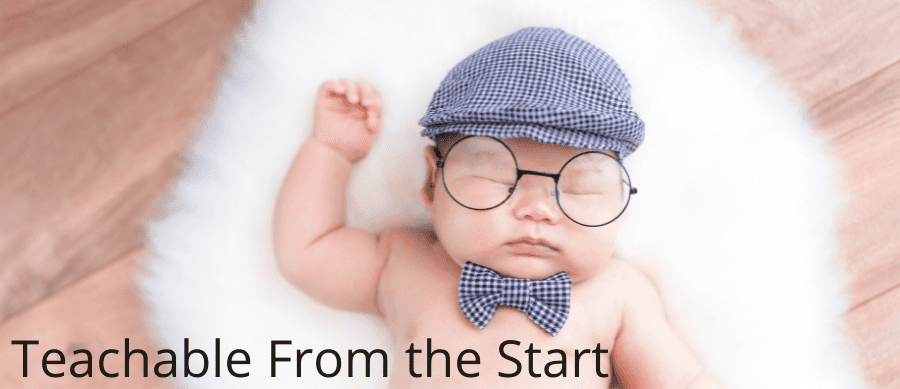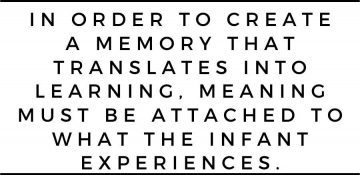Teachable From The Start

Even before birth, an infant is interacting with and genuinely learning from its surroundings. Scientists now understand that a child’s brain development begins in the womb and continues most rapidly from birth to age 3. As educators in the church, we need to recognize this as a great opportunity to influence genuine biblical learning (discipleship) from the very beginning. Babies are teachable from the start!
Newborns Are Learning
Every baby is born with 100 billion brain cell “neurons” that are mostly unconnected. Connections between these neurons, called synapses, are created as a baby has sensory experiences (touching, hearing, etc.) in their emotional and physical environment. As a synapses pathway is used more often, the brain recognizes its importance and strengthens it so that messages may be sent more efficiently. Basically, a baby’s brain develops in a “use it or lose it” fashion. The more often a message is received from their environment or caregivers, the more the infant’s brain will consider that it’s an important learning to “hold on” to.
Caring Is Teaching
While babies require their every need to be met by caregivers, this “helplessness” can actually be considered a strength because baby’s brains are using this time to learn from their caregivers’ responses. “If babies’ expectations for protection and nurturance are met, then their brains experience pleasure and delight” (Lally & Mangione, 2017). At birth, babies begin actively seeking out care in a way to elicit responses from others to gain attention, contact, and closeness. As parents and caregivers react lovingly to an infant’s needs, the infant learns that they can trust others for their care and they begin to form secure relationships. “‘Tender loving care’ is not only the kind way to treat children but a crucial part of early brain development” (Lally & Mangione, 2017). From these first interactions, babies learn by the modeling of caregivers how to feel, think, and act. They also begin to form understandings of how much they are loved. Scientists have shown how these emotional wirings are fostering the dominant brain development during the first two years of life. Being sensitive to an infant’s needs and responding in a timely manner are two easy ways to support this need for a baby to create secure attachments.
Attaching Meaning to Experiences
 A baby’s brain grows and adapts based on its environment and early experiences. In turn, these experiences will determine how a child expresses emotions, gets along with others, and views future learning. Caregivers can help infants learn by providing loving interactions that help the baby attach meaning to words and experiences. Learning will occur after a baby creates multiple memories by these repeated interactions. A baby’s brain doesn’t retain irrelevant information. In order to create a memory that translates into learning, meaning must be attached to what the infant experiences. An effective way to create this meaning with infants is by pairing experiences with the warm touch, language, and emotion of a responsive caregiver. (Marshall, 2011) It has also been noted that babies will learn with less repetition when they are learning through play.
A baby’s brain grows and adapts based on its environment and early experiences. In turn, these experiences will determine how a child expresses emotions, gets along with others, and views future learning. Caregivers can help infants learn by providing loving interactions that help the baby attach meaning to words and experiences. Learning will occur after a baby creates multiple memories by these repeated interactions. A baby’s brain doesn’t retain irrelevant information. In order to create a memory that translates into learning, meaning must be attached to what the infant experiences. An effective way to create this meaning with infants is by pairing experiences with the warm touch, language, and emotion of a responsive caregiver. (Marshall, 2011) It has also been noted that babies will learn with less repetition when they are learning through play.
“Serve and Return”
When caregivers share secure attachments with babies and ensure that interactions include both meaning and play, they are engaging in immediate brain building as well as building a firm foundation where additional learning can later be added. Child-adult relationships that are responsive, attentive, and based on back-and-forth interactions are called “serve and return.” First, the caregiver notices what a baby is paying attention to. This is the “serve.” The caregiver then “returns the serve” to the child by providing encouragement, support, or acknowledgement. During this “return,” the caregiver can also provide words to reinforce the learning and then wait for the baby to respond in some way. A caregiver can continue to take turns interacting with the child until the baby’s interest wanes. “Serve and return” allows caregivers to capitalize on what a baby is showing interest in by adding further insight and meaning to the learning. It also reenforces to the baby that they are well loved and important to the caregiver and can trust the caregiver to interact in warm, consistent ways.
Early Learning
Our understanding of brain development has exploded in recent years, showing scientists how an infant’s brain begins developing well before birth. Instead of the outdated notion that babies are just in a waiting period to begin learning, we now understand how vital the first months are to real learning and setting a foundation for further growth. Whereas infants begin their learning by trusting others for their care, they continue by learning from the everyday experiences in their lives, especially those experiences that are repeated often. This earliest learning contributes to babies’ current and future emotional, spiritual, intellectual, physical, and social growth and development.
Heather Bonds
Heather Bonds currently resides in Kokomo, Indiana with her husband and two teenage daughters. She has a bachelor’s degree in Elementary Education and is pursuing a graduate degree in Early Childhood Administration which will help her in her role as Director at a private Christian preschool where they minister to 160 students each week. She particularly enjoys learning about brain development in children and how that relates to learning and development.
Additional Resources
Lally, J.R. & Mangione, P.L. (2017). Caring Relationships: The Heart of Early Brain Development. Young Children.
Marshall, J. (2011). Infant Neurosensory Development: Considerations for Infant Child Care. Early Childhood Education Journal.
Arnold, R. & Colburn, N. (2005). Oh! What a Smart Baby. School Library Journal (51,2).



